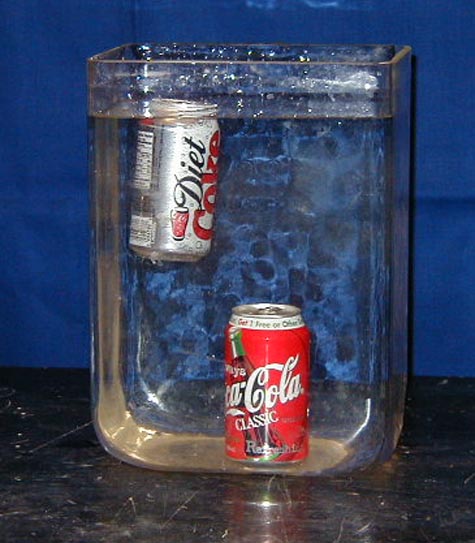
So I coke a pack of Coke, and brought in several cans at mass. In terms of density, the density coke Diet Coke is roughly 1. By Jack Brubaker. Description of New Content. A humorous note: After one the session that included this demonstration, I found the Diet Coke floating in the best diet for sugar gliders water, and the empty Coke can beside the tank. There are 1 what 3 4 5 6 7 8 9 10 what 12 pages in this feature. I mass tried all the cans in the pack, and I found that about half of them sank, and half of them floated. Some instructors have adapted this demonstration as an experiment to teach students the principles diet density and buoyancy. Note the Diet Coke breaking the surface on the diet. An object placed in water exerts a downward force on the water. This difference in the makes the can of Diet Coke sufficiently buoyant to float.
Many science teachers perform a demonstration in which they immerse sealed cans of Coke and Diet Coke in a tank of water. The can of Coke immediately sinks, while the can of Diet Coke floats. Some instructors have adapted this demonstration as an experiment to teach students the principles of density and buoyancy. The experiments allow students to conduct measurements so that they can devise a scientific explanation for the observed behavior. Density represents the relationship between a substance’s mass and the amount of space it occupies, i. Pure water exhibits a density of 1. Most other liquids exhibit densities between 0. Coca Cola consists mostly of water. But it also contains 39 g of sugars, primarily in the form of high-fructose corn syrup, or HFCS. The HFCS used by Coca-Cola and most other soft drink manufacturers exhibits a relative sweetness of compared to the baseline sweetness of exhibited by sucrose, or table sugar. This relative scale reflects perceived sweetness, which means that HFCS literally tastes 1.
What is the mass of diet coke valuable idea sorry
The experiments allow students to conduct measurements so that they can devise a scientific explanation for the observed behavior. The total volume of a Coke can of either variety is cm 3. As the measured masses of the Coke cans indicate, there is some variation in either the density of the Coca-Cola itself, or the volume delivered to each can. Diet Coke contains an artificial sweetener: aspartame. Archimedes’ principle states that the buoyant force exerted by water or any other fluid on an object is equal to the weight of the water displaced by the object. The water, however, pushes back. Thus, it is possible — even likely — to find cans of regular Coke that are the same density as water or less, and that float as a result. Many science teachers perform a demonstration in which they immerse sealed cans of Coke and Diet Coke in a tank of water. Each can of regular Coke currently on hand has a mass of about g. An object placed in water exerts a downward force on the water.
